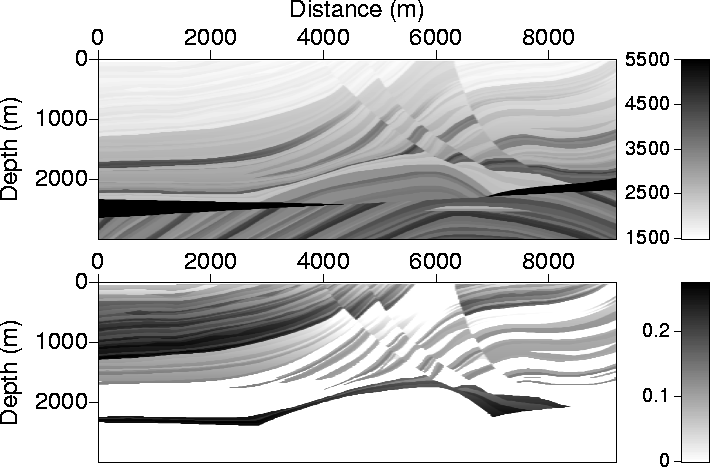 |
Figure 1 Top: The original Marmousi velocity model given by IFP. Bottom: An
The original Marmousi model was built to resemble an overall continental drift geological setting. Numerous large normal faults were created as a result of this drift. The geometry of Marmousi is based somewhat on a profile through the North Quenguela through the Cuanza basin Versteeg (1993). The target zone is a reservoir located at a depth of about 2500 m. The model contains many reflectors, steep dips, and strong velocity variations in both the lateral and the vertical direction (with a minimum velocity of 1500 m/s and a maximum of 5500 m/s). However, there is no clear evidence of the Marmousi model intended sediment or rock distribution, and this includes the distribution of shales. As a result, the same discard for sediment distribution, that went into building the sediment content of the original model, is used here. This is justified by the fact that our goal is purely imaging. Nobody seemed to care for the geological aspect of the model.
 |
Figure 1 (top) shows the original
velocity model used by the Institute Francaise du Petrole (IFP)
to generate the Marmousi synthetic data set. Figure 1 (bottom) shows an ![]() model that
is based on the following two hypothetical assumptions:
model that
is based on the following two hypothetical assumptions:
As mentioned in the previous section,
three parameters describe wave propagation in an acoustic VTI model. The parameter
![]() is perhaps the most influential with respect to
the anisotropic influence on imaging and focusing Alkhalifah and Tsvankin (1995). On the
other hand, vv is responsible
for the depth positioning of reflectors. In this model, vv is set to equal the NMO velocity, v, because
theoretically vv is unresolvable from surface P-wave seismic data Alkhalifah et al. (1997); Alkhalifah (1997c).
It can only be obtained from well data, and such information is beyond the scope
of this paper. Apart from the imaging issue, fitting an isotropic model to anisotropic data
results in over-estimation of NMO velocity, and thus over-estimation of depth even if the vertical
velocity equals the NMO velocity Alkhalifah (1997b).
is perhaps the most influential with respect to
the anisotropic influence on imaging and focusing Alkhalifah and Tsvankin (1995). On the
other hand, vv is responsible
for the depth positioning of reflectors. In this model, vv is set to equal the NMO velocity, v, because
theoretically vv is unresolvable from surface P-wave seismic data Alkhalifah et al. (1997); Alkhalifah (1997c).
It can only be obtained from well data, and such information is beyond the scope
of this paper. Apart from the imaging issue, fitting an isotropic model to anisotropic data
results in over-estimation of NMO velocity, and thus over-estimation of depth even if the vertical
velocity equals the NMO velocity Alkhalifah (1997b).
For the VTI model, the NMO velocity, v, is given by the IFP original velocity model.
The anisotropy parameter ![]() is built to inherent the layering of the original IFP velocity model.
This task is accomplished
by
imposing three guidelines on
is built to inherent the layering of the original IFP velocity model.
This task is accomplished
by
imposing three guidelines on ![]() :
: